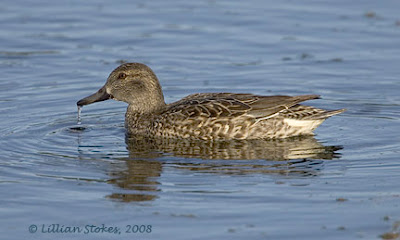
Leucistic female House Sparrow


I recently photographed this interesting, "leucistic" female House Sparrow in GA, with abnormal amounts of white in her head plumage. My first thought when I saw her was, woah, what have we here? An unusual species of bird? Did someone spill paint or something on her head? Was she roosting at night on a branch below the rear end of another House Sparrow and got you-know-what on her head (we've seen that happen with Turkey Vultures)? I quickly realized, none-of-the-above and that her plumage was actually white.
There's not total agreement on
what constitiutes leucism vs. varying degrees of albinism in birds. Some say a bird with any amount of abnormal white plumage, but with dark eyes, would be leucistic. Some say an albino bird has no pigment in its feathers, bills or legs, thus would be all white with pink eyes. Whatever the definitions, one thing is certain. Leucistic birds and albino birds attract a large amount of attention.
- A hummingbird website, the Hilton Pond Center for Piedmont Natural History, got national media attention when they
banded an albino hummingbird.
- Then there was the
photo of a mostly white Pileated Woodpecker discovered in the White River National Wildlife Refuge in Feb. 2006 as well as documentation of a second Pileated Woodecker with an abnormal amount of white on its wings, that led to speculation the bird in the famous Luneau video was not an Ivory-billed Woodpecker but a Pileated Woodpecker with an abnormal amount of white.
- A search of
Google images "leucistic birds" leads to many photos of birds with abnormal white in their plumage
We ourselves have seen leucistic Common Grackles, American Crows, America Robins and American Goldfinches.
If you have seen, or have photos of leucistic or albino birds,
email us.
Photos © Lillian Stokes, 2008

 Here are some more photos of Robins drinking out of the puddles. The paler birds are female robins. Couldn't even post photos yesterday here in GA, because of a tornado watch (fortunately we were not affected.) The large flocks of Robins are still here. After the storms passed yesterday, the Robins were on the ground under all the cedar trees, which had dropped some of their berries due to the wind and rain. A Robin banquet. Another perk is that many of the Robins are singing, which reminds us of spring.
Here are some more photos of Robins drinking out of the puddles. The paler birds are female robins. Couldn't even post photos yesterday here in GA, because of a tornado watch (fortunately we were not affected.) The large flocks of Robins are still here. After the storms passed yesterday, the Robins were on the ground under all the cedar trees, which had dropped some of their berries due to the wind and rain. A Robin banquet. Another perk is that many of the Robins are singing, which reminds us of spring.








































